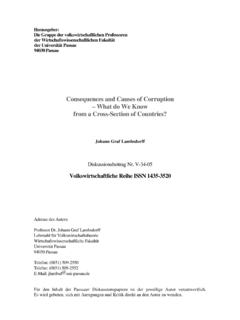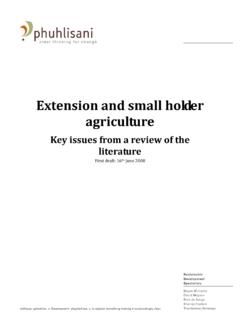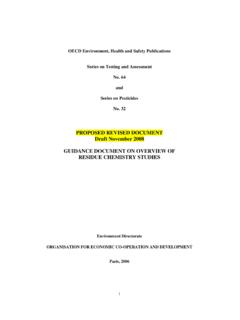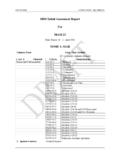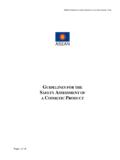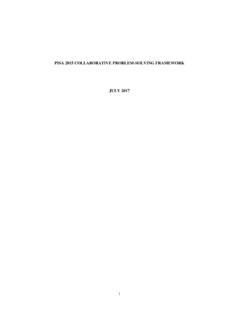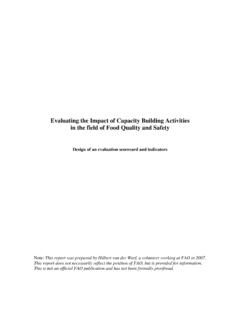Transcription of Research on Corruption
1 1 Research on CorruptionA policy oriented surveyJens Chr. Andvig and Odd-Helge FjeldstadInge AmundsenTone SissenerTina S reideCommissioned by NORADF inal report, December 2000 Chr. Michelsen Institute (CMI) & Norwegian Institute of International Affairs (NUPI)2 PrefaceThis survey, Research on Corruption . A Policy Oriented Survey , is an overview ofcontemporary Corruption Research . The main objective is to present Research that isrelevant for foreign aid policies to developing countries. The survey is commissionedby the Norwegian Agency for Development Co-operation, NORAD.
2 An earlier draftversion of the study was disseminated to the participants of the workshop Corruption : Critical Assessments of Contemporary Research , held in Oslo, 19-20 October survey may be somewhat biased towards economic approaches, reflecting the factthat the writing and editing has primarily been done by the economists Odd-HelgeFjeldstad (CMI) and Jens Chr. Andvig (NUPI). In addition, Tina S reide (CMI), alsoan economist, has contributed to chapter 3, However, Inge Amundsen (politicalscientist, CMI) has written chapter 4 and made several contributions to chapters 2 and10.
3 Furthermore, Tone Sissener (CMI), a social anthropologist, has written chapter , hopefully, at least some of the approaches from these two other social sciencedisciplines are readers will note, despite the broad approach of the paper and its substantiallength, several important themes are not dealt with. While we have discussed typicalsituations that give rise to Corruption in different parts of public organisations, Research focusing on specific sectors such as the police, the judiciary and internationalrelations is not dealt with explicitly in the survey.
4 The same applies to literature on theorganisation of corrupt transactions: when and why middlemen arises, what kind ofred tape may endogenously arise and so on. Recent Research on these issues has beenrather thin . Furthermore, this theme opens up for many questions that require amuch more in depth approach than what can be achieved through a priority is that we have focused on recent academic Research . Thus, while asurvey of the output of public commissions dealing with Corruption would be useful,this is not covered by this study.
5 Moreover, to make the survey accessible for a3multidisciplinary audience, the most abstract and technical parts of the literature arepresented in a non-technical way, emphasising the intuition behind the spite of its limitations we hope this survey will be considered useful and used by researchers, students, development practitioners and aid , December 20004 Research on CorruptionA policy oriented SurveyTable of BATTERY OF OF VERSUS BUREAUCRATIC DEEP STRUCTURES OF order and organisations and and the predatory state in from the deep structure of EQUILIBRIUM MODELS OF EMPIRICAL FOUNDATION OF RECENT Research ON OBSERVATIONAL BASIS OF Corruption MEASURED: THE CONSTRUCTION OF Corruption Corruption Perception Index (CPI).
6 Bribe Payers Index (BPI).. level of Corruption and the meaning of an index rankings based on conditional ATTEMPTS TO MEASURE Corruption MORE ACTION Research SCIENCE PERSPECTIVES ON SYSTEMS AND THE CAUSES OF AND INFORMAL AND OF Corruption ON PERSPECTIVES ON S RATIONAL-LEGAL BUREAUCRACY Corruption : THE CONVENTIONAL DISTINCTION IN SOCIAL METHODS AND EXAMPLES OF ANTHROPOLOGICAL FIELD WORK STUDIES ON LOGICS INFORMING EVERYDAY logics of logics of solidarity PERSPECTIVES AND QUANTITATIVE ANALYSES OF THE CAUSESOF AND LEVELS OF ECONOMIC RIGHTS AND AND SECTOR SALARIES AND RECRUITMENT OPENNESS AND ASSESSMENT OF REGRESSION ANALYSIS BASED ON SUBJECTIVE PERSPECTIVES AND QUANTITATIVE ANALYSIS OF THECONSEQUENCES OF AND BENEFITS OF AND PUBLIC SECTOR AND THE RATE OF AND ECONOMIC AND PUBLIC AND INTERNATIONAL AND THE
7 ABILITY OF OPEN ECONOMY AND THE SIZE OF THE UNDERGROUND ANALYSIS OF CAUSES AND CURES OF BUREAUCRACY-MODELS; PRINCIPAL-AGENT and recruitment and sector and political Corruption MAY CORRUPT - MULTIPLE EQUILIBRIUM LEVEL VERSUS LOW LEVEL in international business Corruption in international business PROCUREMENT AND IN QUEUING IMPORTANCE OF OF ANTI- Corruption WORLD BANK S BRIEF EVALUATION OF THE WORLD BANK S POLICY AHEAD FOR Research ON IntroductionCorruption has recently become a major issue in foreign aid policies.
8 However,behind the screens it has always been there, referred to as the c-word . The majorconcern for international aid policy through the last five decades is to improve theliving conditions for the poor in the poorest countries of the world. This endeavourrequires a close co-operation with the national governments in poor speaking, however, the governments in poor countries are also the mostcorrupt. This is one of the few clear empirical results of recent Research on level of GDP per capita holds most of the explanatory power of the variouscorruption indicators (Treisman, 2000; Paldam, 1999a).
9 Consequently, if donors wantto minimise the risk of foreign aid being contaminated by Corruption , the poorestcountries should be avoided. This would, however, make aid policy rather is the basic dilemma Corruption raises for aid policy. Unlike internationalbusiness most development aid organisations and international finance institutionshave the lion s share of their activities located in highly corrupt countries (Alesinaand Weder, 1999). The international community in general and some donor countriesin particular are, however, increasingly willing to fight the good governance strategies of the World Bank and the InternationalMonetary Fund initiatives to curb Corruption are given priority.
10 OECD and the UNDP have also developed particular anti- Corruption programmes to assist governments intackling the problem. Furthermore, several bilateral development agencies haveplaced anti- Corruption efforts high on their development agenda. Whether this is adesirable change in focus of aid policy, and, hence, whether it is possible to findworkable policy instruments to fight Corruption , remains to be is a problem that mainly arises in the interaction between government andthe market economy where the government itself must be considered it is complex to handle from a theoretical point of view.
